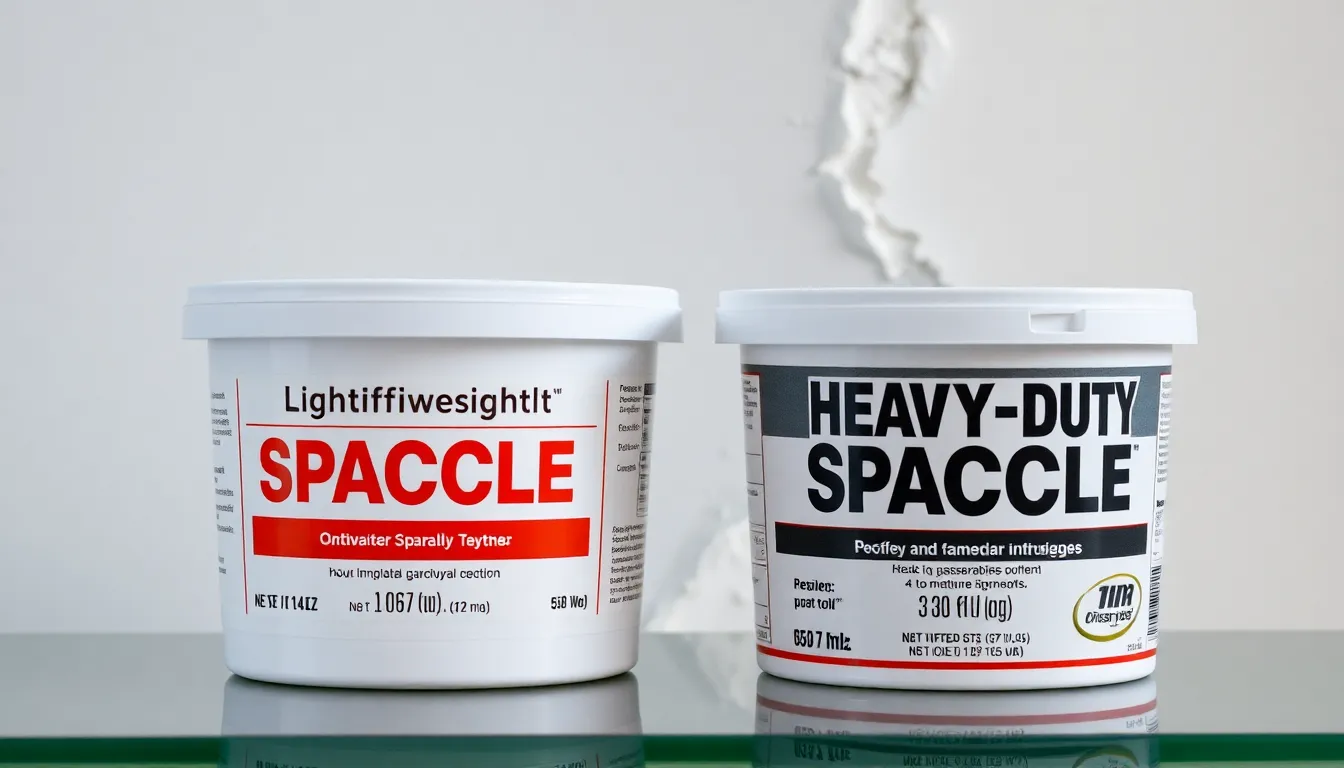Table of Contents
ToggleEver stared at that dingy wall with a hole big enough for a family of squirrels to move in? Spackle drywall might just be your new best friend. This magical paste transforms your wall from a patchy disaster to a smooth, pristine canvas faster than you can say “DIY hero.”
Overview of Spackle Drywall
Spackle drywall serves as an effective solution for repairing various wall imperfections. This compound consists mainly of gypsum and is lighter than traditional joint compound. Lightweight characteristics make spackle easier to apply and sand, facilitating a quicker repair process.
Versatility defines spackle. It works well on a range of drywall issues, including small holes, cracks, and dents. For instance, a 1-pound container can address multiple minor repairs around a home, cutting down time and resources.
Application methods vary. Users apply spackle with a putty knife or a trowel. For small jobs, a simple 2-inch knife suffices. Larger repairs may require wider tools for even coverage.
Drying times range between 30 minutes to several hours, depending on the thickness of the application. In general, thinner layers dry faster and provide a smoother finish. Observing the manufacturer’s instructions ensures optimal drying times and results.
Sanding becomes necessary once the spackle dries completely. A fine-grit sandpaper works best, helping achieve a seamless blend with the surrounding wall. Achieving a smooth surface paves the way for painting or wallpapering, enhancing the overall appearance of the room.
Choosing the right spackle brand impacts the repair’s effectiveness. Numerous products are available, each designed for specific applications. Some brands target quick repairs, while others focus on durability for larger projects. Understanding the options allows for informed decision-making.
Spackle drywall offers an efficient approach to minor wall repairs, facilitating quick and effective transformations. Its user-friendly application and fast-drying properties make it a staple for both professionals and DIY enthusiasts.
Types of Spackle

Spackle comes in various formulations, each tailored to specific repair needs. Understanding these types can enhance repair efficiency and effectiveness.
Lightweight Spackle
Lightweight spackle suits small repairs and minor imperfections. This type dries quickly, allowing for prompt sanding and painting. It features a smooth texture that blends well with drywall, creating an almost invisible repair. Typically, it contains air for reduced weight, making application easy and manageable for most users. Many DIY enthusiasts prefer lightweight spackle for filling tiny holes and hairline cracks because its consistency simplifies the smoothing process. A 1-pound container can cover multiple small repairs without hassle, ensuring a quick fix when time is of the essence.
Heavy-Duty Spackle
Heavy-duty spackle is ideal for larger repairs and significant damage. This formulation provides a tougher solution, effectively filling deep cracks and larger holes. Its strength allows it to withstand impacts and resist cracking during the drying process. Many professionals opt for heavy-duty spackle when working on more extensive projects, where durability is crucial. Using a putty knife during application ensures the material adheres well to the surface, yielding optimal results. A 1-quart container serves well for larger jobs, providing ample coverage for multiple significant repairs while maintaining a reliable finish.
Benefits of Using Spackle for Drywall
Spackle offers several advantages when repairing drywall, making it an essential tool for both professionals and DIY enthusiasts.
Easy Application
Applying spackle requires minimal tools, making the process user-friendly. A putty knife or trowel generally suffices to spread the compound smoothly over damaged areas. This approach simplifies the repair process and ensures even coverage. Various spackle types cater to specific needs, allowing users to select the most suitable product for their repair tasks. Lightweight spackle, for example, spreads easily, allowing for a more efficient application. Overall, spackle’s ease of use encourages more people to tackle home repairs confidently.
Quick Drying Time
Fast drying time significantly enhances the efficiency of spackle usage. Many lightweight formulations can dry in as little as 30 minutes, allowing users to proceed with sanding and painting shortly after application. This quick turnaround reduces overall project time, enabling repairs to be completed promptly. The rapid drying property also minimizes the disruption in daily activities. After drying, spackle can usually be sanded with fine-grit sandpaper for a smooth finish. Such efficiency makes spackle drywall a preferred option for minor repair jobs.
Common Uses of Spackle on Drywall
Spackle serves multiple purposes on drywall, addressing various repairs and surface finishes effectively.
Filling Holes and Cracks
Filling holes and cracks represents one of the primary uses of spackle on drywall. Small holes from nails or screws can be quickly filled with lightweight spackle. Larger cracks require heavy-duty spackle that adheres firmly and provides a reliable seal. Application involves pressing the spackle into the damaged area, ensuring all gaps are filled. Each layer can dry in about 30 minutes, allowing for efficient repairs. After drying, sanding smooths the area, making it ready for paint. Homeowners find spackle an essential tool for maintaining wall integrity.
Smoothening Surfaces
Smoothening surfaces involves eliminating imperfections for a flawless finish. Spackle creates a uniform surface, especially after repairs, enhancing paint application. A putty knife spreads spackle evenly across dents and uneven patches. Techniques like feathering edges can blend spackle into surrounding drywall, ensuring invisibility. Drying time generally ranges from 30 minutes to several hours, depending on thickness. Once dry, light sanding reveals a smooth, ready-to-paint finish. Many professionals and DIYers prefer spackle for its effectiveness in delivering visually appealing surfaces.
Tips for Applying Spackle on Drywall
Ensure the surface is clean and free of dust before starting the application process. Remove loose debris with a damp cloth or sponge. Select the appropriate spackle for the repair type; lightweight spackle works best for small holes while heavy-duty spackle suits larger cracks.
Apply spackle using a putty knife for optimal control. Holding the knife at a slight angle to the wall promotes even distribution. Start by pressing the spackle firmly into the damaged area, then smooth it out with long, even strokes. Build layers gradually if filling deep cracks; allowing each layer to dry completely before adding more enhances stability.
Consider drying times which can range from 30 minutes to several hours, depending on the product used. Check the manufacturer’s instructions for specific drying times and sanding recommendations. Use fine-grit sandpaper to smooth the surface once fully cured. Sanding lightly promotes a seamless finish that blends well with surrounding drywall.
Feathering the edges of the spackle creates a smooth transition between the repaired area and the existing wall. Employ gentle, circular motions to blend edges effectively. Assess your repair under good lighting to identify any uneven spots that require additional spackle or sanding.
Finalize the repair by painting over the dried spackle to match the surrounding wall color. Choose a paint that matches your existing wall finish for best results. Following these steps ensures a professional-looking repair that enhances the integrity and aesthetics of your walls.
Spackle drywall proves to be an invaluable asset for anyone looking to maintain or enhance the appearance of their walls. Its lightweight nature and quick drying times make it a go-to choice for both minor and significant repairs. With various formulations available, users can select the right type for their specific needs, ensuring optimal results.
The ease of application encourages DIY enthusiasts to tackle repairs confidently, while professionals appreciate its efficiency. Proper technique and attention to detail during application and finishing can lead to a flawless surface ready for painting or wallpapering. By incorporating spackle into their repair toolkit, homeowners can achieve smooth and durable walls, elevating the overall look of their living spaces.




